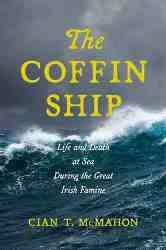 Pirates and Privateers Pirates and Privateers
The History of Maritime
Piracy
Cindy Vallar, Editor
& Reviewer
P.O. Box 425,
Keller, TX 76244-0425
    
Books for
Adults ~ History: Maritime

The Coffin Ship: Life and
Death at Sea during the Great Irish Famine
by Cian T. McMahon
New York University, 2021, ISBN 978-1-4798-0876-2, US
$35.00
Also available in other formats
    
Emigration
from Ireland begins long before the 19th century and
continues after its conclusion, but during the
potato blight that causes the Great Famine, there is
a mass exodus of people from the country. They sail
on vessels that become known as “coffin ships,”
because one in three emigrants die during the
journey. This label presents a history of only one
dimension and fails to provide a true understanding
of the emigration process that these Irish men,
women, and children endure. McMahon employs this
term for the book’s title to challenge the
established concepts of this diaspora and open up
new venues of discussion and research that enlighten
and expand on our understanding. He does so by
sharing what the emigrants think of and experience
during their journeys using their letters and
diaries, as well as newspapers, government
documents, and guidebooks of the period.
To best comprehend the context of the Great Famine,
McMahon sets the stage with a brief look at what
Ireland is like before the blight. This is a time
when the majority of landowners are Protestants who
lease their lands to tenant farmers. Many are poor,
but their lives are enriched by the social community
in which they live. The blight strikes first in
1845, and the mass exodus of Irish because of the
resultant famine ends a decade later. This is the
timeframe that McMahon focuses on here. At the
beginning, Ireland has a population of 8,500,000,
one million of which will die during the Great
Famine. Two million choose to escape the dire
conditions, but there aren’t enough ships to carry
them; this leads to delays, additional expenses, and
problems that the emigrants have to confront. So how
do they cope?
He divides his analysis of this question into five
segments: Preparation, Embarkation, Life, Death, and
Arrival. Chapter one focuses on how the Irish gather
the necessary resources to leave Ireland. This is
but the first step as chapter two shows by examining
how the emigrants travel to their embarkation
points. Both of these illustrate that an intricate
network of relationships exist to help them to
acquire the tickets and items they need for the
journey and to get to the port – most often
Liverpool, England – where they can board a ship
that will take them to their new homelands.
Chapter three concerns the ocean voyage itself,
while chapter four deals with death at sea. What
life is like and how the emigrants adapt are key
components here, as is how their shared experiences
dissolve old bonds of the past to form new bonds to
cope with life and death at sea. The final chapter
discusses what happens once the ships dock at their
destinations, the challenges the immigrants face,
and the revamping of relationships tying them to
their new homes in addition to the one of their
birth.
Part of the Glucksman Irish Diaspora Series, The
Coffin Ship includes an essay that discusses
the sources McMahon consulted and his methodology.
Graphs and illustrations are interspersed throughout
the narrative. Endnotes, a bibliography, and an
index round out this study.
Most histories concern the emigrants who travel to
America, but McMahon includes those who sail to
other parts of the world – Canada, England,
Australia, New Zealand – and includes the convict
experience as well. Through the use of poetry and
quotations from primary documents, he breathes life
anew into these individuals so that readers
experience their emotions, joys, and sufferings. He
also shows how the migratory process works and
consists of reciprocal means that extend far beyond
the national boundaries of Ireland to reconnect
Irish immigrants with those left behind. We often
think that emigrating is a solitary experience, and
to some degree it is, yet McMahon also shows how
helping hands exist all along the way, allowing
social bonds to dissolve, reform, and reconstitute
themselves. Even though his study focuses on the
Irish diaspora, he connects it to current issues
concerning refugees. This is an invaluable addition
for any collection dealing with the Great Famine,
the Irish diaspora, and the refugee experience.

Click to contact me
Background image compliments
of Anke's Graphics |

